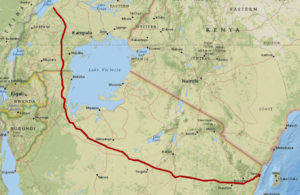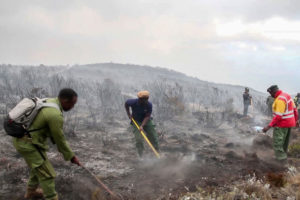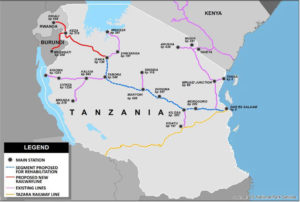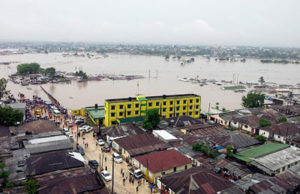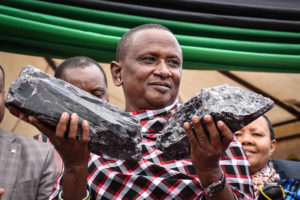by Martin Walsh

DEVELOPMENT AS REBELLION: A BIOGRAPHY OF JULIUS NYERERE. Issa Shivji, Saida Yahya-Othman, and Ng’wanza Kamata. Mkuki na Nyota Publishers, Dar es Salaam, 2020. xxiv + 1,101 pp. (hardback, three-volume box set). ISBN: 9789987084111. £90.
This amazing trilogy of books, long in the making, will add to the necessity for the study of Julius Nyerere as one of the most important philosophers, revolutionaries, writers, development theorists, politicians, leaders and human beings of the 20th century. The roster of endorsements for this three-volume set points to how extraordinary and important its publication is. Thabo Mbeki and Ngugi wa Thiong’o lead a list that includes some of the most significant figures in Tanzanian, African and radical scholarship and political life over the past half-century. That roster is also fitting given the prominence of the three authors, all of whom are associated with the University of Dar es Salaam. Each author took the lead with one volume (Yahya-Othman with volume 1, Kamata with volume 2, and Shivji with volume 3). The books fall (roughly) in chronological order. Volume 1, The Making of a Philosopher Ruler, builds from YahyaOthman’s expertise in literature and linguistics (and Nyerere’s significance as a scholar and writer) to tell the story of his early life, family and friendships, and engagements with the scholarly world. Volume 2, Becoming Nationalist, covers the years from the birth of the Tanganyika African National Union (1954) to the death of Abeid Amani Karume (1972), centring on the emergence of Nyerere’s life as a national political leader. Volume 3, Rebellion without Rebels, the thickest of the three books, overlaps somewhat chronologically with the first two volumes but takes us through to the end – Nyerere’s death in 1999 – and into Mwalimu’s posthumous legacy.
Many people have written about Nyerere, and several biographies are well known, but this is the only one with an all-Tanzanian team of authors. All the authors knew Nyerere personally to varying degrees, and all three were steeped in the intellectual and political life of the Tanzania Nyerere created.
There is no way to comprehensively review the massive and complex content in such a brief review essay. Furthermore, I have little to criticise, given the awesome work in which the authors engaged – from interviews with a wealth of global figures and Tanzanians, including virtually all its leaders and Nyerere’s surviving boyhood friends and neighbours, to archival research that often included something more like archival hunting – and the thorough and nuanced writing. Rather than full summaries of the three volumes, I offer glimpses into key points of emphasis within each.
Volume 1 has few surprises for those familiar with Nyerere’s life story, but the emphasis toward his relationships with women and his (uneven) awareness of women’s issues and perspectives makes this volume stand out. Right from the first chapter, the reader sees this in a concentration on his relationship to his mother and eventual responsibility for her well-being in Butiama. Chapter 2, on “Family and Friends” begins with a long, deep segment on the “Mother of the Nation”, Nyerere’s wife, Maria. The attention to his long relationship with the Mary Knoll sisters as part of his sparring with his own Catholicism continues the emphasis on relations with women, alongside coverage of his romantic entanglements outside of marriage. The most fascinating relationship of all was with Joan Wicken, his long-term personal assistant and the “lady behind the throne”, author of most of his speeches and a deep influence for 34 years. Yahya-Othman brings a focus on another form of love – Nyerere’s love of books and of literature – to chapter 3, with analysis of his translations and his own books of essays. That flows seamlessly into chapter 4’s study of his “Scholarly encounters”. which is especially oriented around his relationship to “The Hill” (the University of Dar es Salaam, for which he served as an interventionist Chancellor during his Presidency), and its student leaders and faculty. What emerges in volume 1 is a well-rounded appreciation for Nyerere as a complex and flawed human being who loved and was loved by those whom he was closest to in life.
Volume 2 is the shortest and tightest of the three books. Consisting of only two chapters (which are admittedly 118 and 88 pages long, respectively), it is a page-turner, a breathless run through the heart of Nyerere’s political career. It begins before that career began, with a history of the African Association in Tanganyika and Zanzibar. We then see Nyerere’s emergence, first as TAA President and then as the leader transforming it into TANU. Tanganyika’s path to independence is often taken as a straightforward, non-violent one, certainly in comparison to that of its neighbours. Kamata’s volume should dispel such misreadings, as his journey through the search for the “political kingdom” (chapter 5) highlights the tensions both within and without TANU. He effectively explores the complexity behind the general understanding of Nyerere as a “moderate” voice taking apart the sense of any inevitability in the progress toward both independence and Ujamaa socialism. The intensity of the internal struggles within and opposition to the government between 1961 and 1964 in chapter 5 builds in chapter 6’s discussion of the union with Zanzibar. The best illustration of Kamata’s nuanced analysis comes in his succinct note on the events from January through April 1964 (Zanzibar’s Revolution, the Tanganyika Army’s mutiny, and the union): “events were moving so fast that it appeared they might all be part of a grand scheme. It wasn’t. In retrospect, they were all historical outcomes of a long period of grievances and injustices which now found expression in unpredictable places and forms” (pp. 119-120). Here and throughout the sweep of this narrative, Nyerere appears, as Kamata puts it, as “both a victim and an actor” (p. 120). Far from the mastermind of everything (the revolution and the union) and conniver with (fill-in-the-blank – British colonialists, American imperialists, Soviet communists), Nyerere – part victim, part actor – seemed to continually find himself stuck in a political morass for which he only bore or accepted partial responsibility, and out of which he seemed to navigate in the most expedient means at hand. This interpretation is particularly helpful for recasting Nyerere’s relationship with Zanzibar, from his presence at the creation of the Afro-Shirazi Party in 1957 to his intervention in the disputed 1995 multi-party elections there. Zanzibar and the union remained the largest “headaches” that Nyerere had in his political career. His culpability in the deaths of Kassim Hanga and Othman Sheriff (and others) are among the darkest stains on his legacy.
Volume 3 will likely be the portion of the trilogy to garner the most attention, in part because it is as long as the other two combined. At the same time, its narrative flows comfortably from the first two, and especially from where Kamata leaves us. Shivji returns the reader again and again to the disconnect between Nyerere as a man with unquestioned “personal integrity and moral probity” and Nyerere as a politician operating in morasses like those discussed above. It is fascinating to see, in volume 3’s first post-preface footnote, that former Zanzibar President Salmin Amour, claimed in an interview with the authors that Nyerere “learnt his politics from Gandhi and Machiavelli” (p. 1). Shivji’s first chapter (the trilogy’s chapter 7) places Nyerere in the global canon of political philosophy more broadly than that, but the image from that footnote lingered through my reading of Rebellion without Rebels. Here, we revisit several of the key events on volume 2’s timeline and key texts and boyhood moments analysed in volume 1 from that broader canvas. The contradictions of Nyerere’s life are not resolved, as they should not be. Shivji is perhaps uniquely positioned to analyse Nyerere’s place in relation to Marxism and radical political philosophy, and, unsurprisingly, there is a depth to this volume that is profound, yet subtle.
Chapter 8 deals with the Arusha Declaration, Chapter 9 with Ujamaa in practice, Chapter 10 with the Kagera War, and Chapter 11 with what Shivji calls the “Class War.” In each case, the contradiction appears, the flip-switch between Gandhi and Machiavelli. Chapter 9 reveals the reasoning behind the title for the trilogy, and the borrowing from Nyerere’s concept of “development as rebellion”: what Tanzania got, Shivji contends, was a rebellion without rebels, and where the workers “wanted to build socialism themselves, [but] Nyerere wanted to build it for them” (p. 231). To me, the most intriguing of these four big chapters is Chapter 11, which focuses on Nyerere’s last years as President, the struggles with the IMF, the merger of the parties, and the resurgence of Zanzibar’s autonomist and anti-union forces.
Nyerere, Shivji concludes, “left behind a legacy that has since haunted his successors and […] standards of political behaviour that have been hard to beat” (p. 405). The Swahili saying, ‘mtu ni watu’, a person is people, comes to mind at the end of the trilogy, for its conventional meaning and for a perhaps unconventional one. Nyerere is not Nyerere, by the conventional interpretation of the phrase, without all the people with whom his life was threaded, and this is easily read in this 1,100-page tome. But the trilogy brings home to me a different interpretation: Nyerere was many different people during his life. He was a brilliant thinker and charismatic orator, a pragmatic politician and a failed idealist, a humble moderate and a cut-throat rebel, a Christian and a socialist. And, as the final chapter declares, he was, of course, the founder and father of a nation, whose people he loved more than their political parties. As one of the countless westerners inspired to African studies and African philosophy through his example in my own life, I am grateful to these three authors for illuminating all these Nyereres in this trilogy.
I would be remiss in reviewing this triple-decker biography if I did not note that the books are beautifully designed and produced. Mkuki na Nyota has been a mainstay of African publishing for several decades, but this trilogy may just be its best achievement in artistic and production qualities. The authors plan a 4th volume focused on Nyerere’s global role as a ‘statesman of the South’, and it is awaited with great anticipation.
Garth Myers
Garth Myers is the P.E. Raether Distinguished Professor of Urban International Studies at Trinity College, Hartford, CT USA, where he also directs the Center for Urban and Global Studies. He is the author of five books and over 80 book chapters and articles, as well as co-editor of two volumes of scholarship, the vast majority of which concerns African urban development, with a special emphasis on Tanzania.
Given widespread interest in the Nyerere trilogy, and its importance for Tanzanian Studies, here are some further thoughts from our editor:
In this three-volume work, Issa Shivji, Saida Yahya-Othman and Ng’wanza Kamata have compiled a remarkable biography of a remarkable man. Their meticulous research – drawing on a wide range of previous scholarship, documentary sources and an impressive list of interviewees – shines through from beginning to end.
Without doubt, the three writers greatly admire their subject, most of all for his personal integrity and egalitarian political philosophy. But they are not blind to his flaws.
They engage at length with the most obvious contradiction in Nyerere’s life and work: the sometimes-glaring gap between the liberalism he espoused and the highly illiberal actions he took himself as leader (or allowed to happen). Preventive detention of political opponents and the use of paramilitary force to relocate millions of citizens into villages are a long way from the ideals Nyerere expressed when he said “I believe in freedom because I cannot think and develop without freedoms. This must be true of every human being.” On this, Nyerere’s own justifications are presented – which essentially boil down to pragmatic appeals to the greater good – but challenged. Nyerere’s arguments in favour of constitutional provisions giving himself what were essentially dictatorial powers are described as “defending the indefensible”, and Nyerere’s lack of respect for freedom of association as “blatant” and “disingenuous”. Without ever spelling them out, the authors clearly have views on the relevance of this history to present-day Tanzania.
The authors, however, may well take issue with my describing this as the most obvious contradiction, as their primary interest lies elsewhere. In the third volume, Shivji argues that “the central contradiction of Nyerere’s ideology” was the assumption “that socialist transformation will be achieved through class collaboration rather than class struggle.” There is no doubt that this biography’s critique of Nyerere’s economic policies – Ujamaa in particular – comes firmly from fellow travellers on the left. There is a lot of value in this: criticism of a particular form of socialism in practice by critical friends allows for a lot more subtlety and nuance in the analysis than the broad-brush dismissals of those on the right.
Nevertheless, at times, this leads the authors into some odd assumptions about their readers’ prior knowledge. It is assumed, for example, that readers will understand fine distinctions between variations in socialism, such as what is meant by a party of cadres and a vanguard party. Marxist scholars surely would, but many others will not. In contrast, they explain the term neoliberal economics in very basic terms.
More seriously, the authors’ perspective also means that they ignore some of the most widely heard critiques of Ujamaa. Tanzania’s economic difficulties of the 1970s and 1980s are not blamed on a lack of competition or incentives – as many (particularly international) analysts have argued – but on a combination of mismanagement and corruption on the part of parastatal leaders, interference from neo-colonial powers and other international economic pressures. These factors surely played a major role, but at the very least, serious engagement with the right-of-centre critiques would have been useful. This perspective is, after all, hardly immune to criticism.
Away from economics, one further contradiction is arguably not given sufficient attention: Nyerere’s attitude to women. His progressive (for the time) writing on the subject is discussed, but there is little on his actions – either as a reputedly inattentive husband and father or in the public sphere. It is not mentioned, for example, that the first post-independent cabinet was all-male. It included neither Bibi Titi Mohammed nor Lucy Lameck, who were respectively more experienced and better educated than some of the appointees. Similarly, Nyerere’s later treatment of Bibi Titi passes largely without comment. Having previously been at the forefront of the independence campaign, she lost her seat in parliament in 1965, concluding that this was at least in part because those at the top did not want her to win. In 1967, she was hit hard by the Arusha Declaration’s leadership code that blocked party leaders from renting out property. She spoke up against the code and resigned her positions, then three years later found herself convicted of treason, on the basis of evidence that other observers consider far from watertight. In short, it looks a lot like Bibi Titi was brought into the fold when it was useful to do so, then unceremoniously dumped when she became a potential rival.
There are other matters, too, where more detail would have been welcome. The high-level politics of the independence campaign are covered in depth, but there is much less on the grassroots movement. There is little on Nyerere’s (highly successful) efforts to build a nation out of many different tribes, or on his use and promotion of Swahili as a means to this end. And while his postretirement influence on specific political decisions is discussed, there is almost nothing on his ongoing, posthumous place in the public imagination.
Nevertheless, this is nit-picking. And asking for more from a work this length is a sign of how well-researched and well-written it is – this reader did not want it to end. This is a hugely impressive work, one that adds greatly to scholarship on Nyerere and the modern history of Tanzania. It is fascinating when engaged in the details: on forced villagisation, the deaths of Kleruu and Sokoine, the 1964 mutiny, the Ruvuma Development Association, the war with Uganda, and the tensions with CCM’s Zanzibar contingent. But it is equally so when exploring matters of philosophy and ideology. No glib conclusions are offered, but the evidence has been gathered in meticulous detail and is presented and discussed with immense respect and admiration for their subject.
It has clearly been a labour of love to produce. In my case at least, it was a labour of love to read as well – hugely enjoyable, thought-provoking, and consistently fascinating.
(Reproduced and adapted from https://mtega.com/2020/07/julius-nyereredevelopment-as-rebellion-some-thoughts/).
Ben Taylor
Ben Taylor is the Editor of Tanzanian Affairs.
UNDER-EDUCATION IN AFRICA: FROM COLONIALISM TO NEOLIBERALISM. Karim F. Hirji. Daraja Press, Ottawa, 2019. xxii + 294 pp. (paperback). ISBN 978-1-988832-35-7. CAD $26.00.
Following his 2018 book on The Travails of a Tanzanian Teacher, Karim Hirji has published a collection of critical essays on Under-Education in Africa. This is not a direct sequel to the previous one volume, though both are unified by their concern with what he regards as a decayed educational inheritance. Professor Hirji’s experience as a teacher-cum activist makes him a vigorous exposer of instances of under-education, and he doggedly pursues evidence of the perpetuation of colonial and neocolonial thinking in Tanzania.
Hirji is saddened by the current state of affairs, and complains that “the youth of today have little hope for a good future”, as they succumb to a disorientated and unresponsive educational milieu, marred by rote memorisation and dominated by the effects of the profit-making that was introduced by the policies of economic liberalisation and privatisation. Against the prevailing passivity, Hirji recommends mending the flawed educational system by revitalising critical thought, creativity and freedom of expression. He cites progressive intellectuals of the 1970s and 1980s such as Walter Rodney, Abdulrahman Babu, Haroub Othman, Ali Mazrui, Dan Nabudere, Justinian Rweyemamu, Lionel Cliffe, John Saul, Issa Shivji and others as commendable examples.
At the start of the book, Hirji asks “How can education serve the interest of the common people and contribute to the development of a just human society?” He argues that high quality education should not be measured in terms of the number of schools and colleges alone, but must “foster the growth of creative, intellectually mature and astute individuals”. Under-education in his terms is fostered when a nation poorly regulates the expansion of the education system, relying heavily on external funding, and allowing low-quality education linked to a negative attitude to locally-produced knowledge. The result is a fertile ground for corruption, nepotism and unemployment, major features of injustice in an educational context. At the same time, he sees current higher learning systems in Tanzania and Africa at large as merely bookish endeavours that only produce docile minds.
By articulating and critiquing under-education in this way, Hirji joins others like Professors Noam Chomsky and Patrick Loch Otieno (PLO) Lumumba who have similarly advocated for change in education systems that inherently stifle creativity and independent critical thinking in leaners. All these progressive theorists vehemently abhor mindless and meaningless forms of teaching and learning, and Hirji adds an important historical dimension to the analysis of under-education, writing in his characteristically lucid narrative style and weaving in his own experience and memories.
This book will be of interest to readers in search of critical perspectives on education in Tanzania and Africa more widely. It invites the policymakers, teachers and students of today to erase their ‘ideological blinders’. For fellow citizens and observers of Tanzania, it elucidates the ideology of ‘education for self-reliance’ in practice. And, as an authoritative text on under-education, it makes an important contribution to the debates on transformative education and knowledge production in Africa as a whole.
Ahmad Kipacha
Ahmad Kipacha is a Senior Lecturer in the School of Business Studies and Humanities at the Nelson Mandela African Institution of Science and Technology in Arusha. Together with Mwanaaisha Jambo, he has recently published a collection of critical Swahili poems, Mkiya wa Mbuzi (Lulu Press, 2019).

